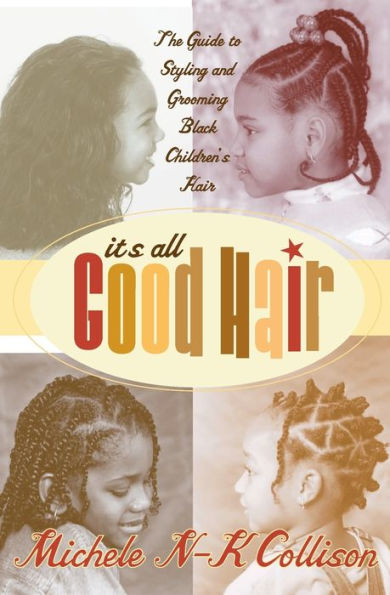Read an Excerpt
Introduction
What are you going to do with that child's hair? My friends started bombarding me with questions when my daughter Maya was around six months old. What did my friends mean when they asked what was I going to do with Maya's hair? I wasn't planning to do anything with her hair. I was a new mother of twins. Do hair? I just wanted to sleep. She was a baby and I let her hair be free. Her brother Michael's hair was even less of an issue. I'd use a soft brush on it occasionally.
But by the time Maya was a year old, it was clear that her freespirited, curly Afro was not working anymore. I would have to do something with her hair. I decided to fall back on the tried-and-true: two neat braids with a part down the middle. The first time I tried to do her hair, I sat her on my lap, just as my mother had done with me. I had all the necessary equipment — the comb, the brush, the barrettes, and the pink oil.
I thought to myself, "I am a college graduate with all kinds of skills and talents. What's so hard about a part and a few braids?" Maya wasn't so sure. She was squirming during my frustrating attempts to get her hair in this simplest of styles.
Finally I was finished. All right, so her part was crooked and her braids were kind of lumpy. At least I had gotten it in a style. I was feeling pretty good about my efforts.
All that changed, though, when my mother came over, rolled her eyes, took one look at her granddaughter's head, and said, "Bring me that child." Fifteen minutes later, my mother had Maya looking like a child in a toothpastecommercial. Her hair was perfect, the braids were flawless, and not one strand of hair was out of place.
Watching my mother do Maya's hair, it seemed so simple and natural. Why then, was it so hard when I tried? My mother had learned from her mother, who learned from her mother. Braiding had been passed down from the people of Africa through their descendants in America. This tradition seemed to have skipped me. I don't even remember braiding my doll-baby's hair. And I couldn't remember the last time I had done my own hair. Ever since I got a job making decent money, I've had a standing weekly appointment with my hairdresser, Tim Gray.
My struggles to learn to do Maya's hair became a running joke. When my friends saw Maya, they laughed and said, "Michele must have done that child's hair." When I picked Maya up from daycare, she would have a new hairstyle every day. Her teacher would just do it over. Finally, she just said, "Bring me a brush and comb so I can do Maya's hair here."
When I would share my hair-care dilemmas with others, they would tell me to just cornrow her hair — as if all Black women are born knowing how to braid. But I was going to have to learn some braiding styles pretty quickly, or other mothers would be clucking their teeth over my poor daughter's hair. Black folks put a premium on nice-looking hair. You simply can't have your child walking around in the Black community with some raggedy-looking 'do.
Eventually, with the help of my mother, I learned how to do some decent ponytails. That worked for about two years. But by the time I mastered simple plaits, Maya raised the ante. My fashion-conscious daughter started demanding more elaborate hairstyles. "Mommy, I'm tired of wearing my hair in two ponytails," Maya would say. "I want my hair to look like that," she'd say as she pointed at the picture of a girl with some fancy braids swept up on her head. (It's amazing the faith children have in their mothers.) Maya didn't know that it was a major accomplishment that her mother had mastered braids. Nor did she know that I couldn't tell a flat twist from a cornrow.
Eventually I learned that I wasn't alone with my hair-care drama. Many other Black mothers and fathers, and White and Biracial mothers, were also secretly ashamed that they don't know how to do their children's hair — folks who had law degrees but couldn't figure out how to make a straight part in their childrens' hair.
Conversation after conversation with Black parents and White parents with Biracial and Black children always turned to, "What do you do with your child's hair?" There are the tears and the drama associated with combing our children's gloriously curly locks. Half the battle in the mornings was trying to get the kids to sit still to get their hair done. My cousin Gina said it was always a struggle to do her daughter Tiara's hair. "First I have to find Tiara. Whenever she sees me pick up that comb, she runs away."
For some parents, the hair salon is their salvation. Mothers told me the way they avoided the hair drama was to schedule a weekly appointment for their young daughters at the salon, some as young as two and three years old. Even though their daughters' hair was done, these mothers still said they felt they should know how to style their own children's hair.
The Broken Link?
For a variety of reasons, many of today's African-American parents have no idea how to properly care for their children's hair. Forcenturies, Africans have been recognized for their intricate braiding styles. And African-American women have vivid memories of sitting between their mothers' or grandmothers' knees as they put Dixie Peach or Blue Beaugamont in our hair. We laugh as...
It's All Good Hair. Copyright © by Michele N-K Collison. Reprinted by permission of HarperCollins Publishers, Inc. All rights reserved. Available now wherever books are sold.



